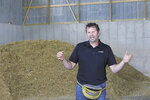
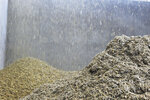
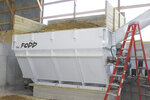
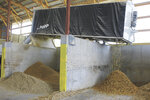
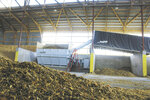
AMERY, Wis. — Feeding dairy cattle is possibly the most important, and potentially the most expensive, act on a dairy farm, with little room for error.
Greg Friendshuh has developed a system that he believes could revolutionize feeding dairy cattle.
“This machine is going to have an impact on the lives of many people, on many dairies,” he said. “It will have an impact on the feed industry overall. How honored am I (to be ) the one to steward it forward.”
The FODD 3.0 is the newest version of the original prototype that Friendshuh has been developing on his farm for four years.
“This system allows us to separate corn silage into high-starch fines and low-starch fodder,” Friendshuh said. “That allows us to feed more corn silage, which lowers feed costs and creates more milk, all with less work. The cows don’t have to eat more to make more milk. The FODD helps them be more efficient at making milk.”
Friendshuh milks 1,250 cows near Amery.
The FODD 3.0 has been in use since February. His herd is averaging 107 energy-corrected pounds of milk per day, and he is shipping 7.42 pounds of combined fat and protein.
Using the FODD 3.0, the Friendshuhs separate 60 tons of corn silage into fines and fodder daily, a process that takes approximately five hours.
The fines are used to make the lactating cow ration. Half the fodder produced is fed to the dry cows, and the other half is fed to the heifers.
“If I had a dairy without youngstock, I would probably sort enough fodder to feed the dry cows and the fines would go to my earlier lactation cows, trying to get their peaks up,” Friendshuh said. “Once they get past about 150 days, you can put them on a corn silage diet, and they would have the capacity to eat enough.”
By feeding fodder to dry cows, Friendshuh has noticed an increase in dry matter intake of over 2 pounds per cow, pre- and post-fresh. That increase benefits the cows through the transition period, with less susceptibility to metabolic issues.
“Corn silage is the most consistent feed on the dairy, but it’s really very inconsistent,” Friendshuh said. “With the FODD, you take that corn silage and run it through a process, and pretty soon, you have homogenized corn silage. Cows love that consistency. Eliminating the variables at the bunk has a big impact. They can’t sort anymore. … Our milk has climbed, and our metabolics are nearly perfect.
Friendshuh said he feeds dual-purpose and hybrid varieties of silage rather than brown mid-rib.
Jim Smith, dairy strategic accounts manager for Pioneer, said the end result of a silage harvest can only be as good as the growing season allows it to be.
“Corn silage is great, but once that pile is there, you’ve got to feed it,” Smith said. “If it’s not good corn silage, you’re going to be fighting it all year, and it’s going to get expensive from a cow health standpoint, milk production, feed costs — everything.”
Smith said FODD 3.0 is a tool that can help dairy farmers manage the variability that arises from environmental conditions affecting their corn silage each year in a way that was not previously available.
The idea for the system was born during a conversation Friendshuh had with his nutritionist, Keith Sather, in 2019.
“Feeding straw was a pain point,” Friendshuh said. “Straw was expensive, hard to find and when you did find it, the quality was poor. We started looking for an alternative. How many times do we have bad bales of straw that get chopped up and we don’t even know about it? This eliminates that factor.”
The idea was to separate the particle sizes of corn silage, eliminating the need for straw in the dry cow and heifer diets.
“The FODD today makes my life easy; everything is consistent now,” Sather said. “We are feeding the dry cows and heifers predominantly with the fodder. That was the focus: to get to the point where we didn’t have to feed straw. We’re there now. We accomplished that goal.”
By being able to manipulate the amount of starch available through the fines and the fodder, Sather said the result is a healthier diet for all animals on the farm.
“We have taken corn silage that was 32% starch and we’re feeding the cows with fines that are 37%-38% starch, so we can have more forage and less concentrate going into the diet,” Sather said. “The fines make an awesome lactating feed, and we’re seeing a fast track to peak milk.”
The FODD allows dairy farmers to improve upon their corn silage crop, no matter how good or bad it might be.
“Where I would love to have a FODD machine to work with is a year like last year when we had really tough weather in the area and I am feeding a silage that is 28% starch,” Sather said. “If I had a FODD machine, I could boost the starch content of that corn silage, and it would make feeding those cows much easier.”
Between decreased feed costs and increased production, the FODD 3.0 could help the bottom line of a dairy farm, said Tim Swenson, of Swenson Management Service LLC.
“This could be a real game-changer,” Swenson said. “The average net income per cow in Wisconsin and Minnesota is about $350 per cow. If we can add another $200 per cow, we’ve changed that profit level substantially.”
Friendshuh estimates feed savings on-farm to be $175 per cow, based on how his ration using the FODD compares to prior rations. On the conservative side, he estimates production to be up over 2 pounds per cow per day. He estimates the payback on the installation of a FODD 3.0 to be under two years, depending on herd size.
“I get excited about this system; it has simplified our dairy, streamlined our operations and made it a more robust system,” Friendshuh said. “This has the potential to change our industry by how we feed our cattle. … It is going to have an impact on good and average corn silage, but the greatest impact will be in those pain years with poor corn silage.”
Comments
No comments on this item Please log in to comment by clicking here